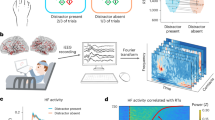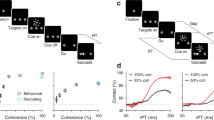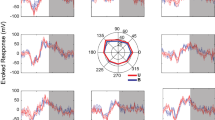Abstract
Bright objects capture our attention by virtue of 'popping out' from their surroundings. This correlates with strong responses in cortical areas thought to be important in attentional allocation. Previous studies have suggested that with the right mindset or training, humans can ignore popout stimuli. We studied the activity of neurons in monkey lateral intraparietal area while monkeys performed a visual search task. The monkeys were free to move their eyes, and a distractor, but never the search target, popped out. On trials in which the monkeys made a saccade directly to the search target, the popout distractor evoked a smaller response than the non-popout distractors. The intensity of the response to the popout correlated inversely with the monkeys' ability to ignore it. We suggest that this modulation corresponds to a top-down mechanism that the brain uses to adjust the parietal representation of salience.
This is a preview of subscription content, access via your institution
Access options
Subscribe to this journal
Receive 12 print issues and online access
$209.00 per year
only $17.42 per issue
Buy this article
- Purchase on Springer Link
- Instant access to full article PDF
Prices may be subject to local taxes which are calculated during checkout





Similar content being viewed by others
References
Cave, K.R. & Wolfe, J.M. Modeling the role of parallel processing in visual search. Cognit. Psychol. 22, 225–271 (1990).
Duncan, J. & Humphreys, G.W. Visual search and stimulus similarity. Psychol. Rev. 96, 433–458 (1989).
Treisman, A.M. & Gelade, G. A feature-integration theory of attention. Cognit. Psychol. 12, 97–136 (1980).
Joseph, J.S. & Optican, L.M. Involuntary attentional shifts due to orientation differences. Percept. Psychophys. 58, 651–665 (1996).
Irwin, D.E., Colcombe, A.M., Kramer, A.F. & Hahn, S. Attentional and oculomotor capture by onset, luminance and color singletons. Vision Res. 40, 1443–1458 (2000).
Theeuwes, J. Cross-dimensional perceptual selectivity. Percept. Psychophys. 50, 184–193 (1991).
Yantis, S. & Hillstrom, A.P. Stimulus-driven attentional capture: evidence from equiluminant visual objects. J. Exp. Psychol. Hum. Percept. Perform. 20, 95–107 (1994).
Theeuwes, J. & Burger, R. Attentional control during visual search: the effect of irrelevant singletons. J. Exp. Psychol. Hum. Percept. Perform. 24, 1342–1353 (1998).
Theeuwes, J. Stimulus-driven capture and attentional set: selective search for color and visual abrupt onsets. J. Exp. Psychol. Hum. Percept. Perform. 20, 799–806 (1994).
Maljkovic, V. & Nakayama, K. Priming of pop-out: I. Role of features. Mem. Cognit. 22, 657–672 (1994).
Kim, M.S. & Cave, K.R. Top-down and bottom-up attentional control: on the nature of interference from a salient distractor. Percept. Psychophys. 61, 1009–1023 (1999).
Theeuwes, J., De Vries, G.J. & Godijn, R. Attentional and oculomotor capture with static singletons. Percept. Psychophys. 65, 735–746 (2003).
Bacon, W.F. & Egeth, H.E. Overriding stimulus-driven attentional capture. Percept. Psychophys. 55, 485–496 (1994).
Yantis, S. & Egeth, H.E. On the distinction between visual salience and stimulus-driven attentional capture. J. Exp. Psychol. Hum. Percept. Perform. 25, 661–676 (1999).
Godijn, R. & Theeuwes, J. Programming of endogenous and exogenous saccades: evidence for a competitive integration model. J. Exp. Psychol. Hum. Percept. Perform. 28, 1039–1054 (2002).
Lamy, D., Tsal, Y. & Egeth, H.E. Does a salient distractor capture attention early in processing? Psychon. Bull. Rev. 10, 621–629 (2003).
Lamy, D., Leber, A. & Egeth, H.E. Effects of task relevance and stimulus-driven salience in feature-search mode. J. Exp. Psychol. Hum. Percept. Perform. 30, 1019–1031 (2004).
Folk, C.L., Remington, R.W. & Johnston, J.C. Involuntary covert orienting is contingent on attentional control settings. J. Exp. Psychol. Hum. Percept. Perform. 18, 1030–1044 (1992).
Rauschenberger, R. Attentional capture by auto- and allo-cues. Psychon. Bull. Rev. 10, 814–842 (2003).
Koch, C. & Ullman, S. Shifts in selective visual attention: towards the underlying neural circuitry. Hum. Neurobiol. 4, 219–227 (1985).
Itti, L. & Koch, C. A saliency-based search mechanism for overt and covert shifts of visual attention. Vision Res. 40, 1489–1506 (2000).
Bisley, J.W. & Goldberg, M.E. Neuronal activity in the lateral intraparietal area and spatial attention. Science 299, 81–86 (2003).
Bisley, J.W. & Goldberg, M.E. Neural correlates of attention and distractibility in the lateral intraparietal area. J. Neurophysiol. 95, 1696–1717 (2006).
Thompson, K.G. & Bichot, N.P. A visual salience map in the primate frontal eye field. Prog. Brain Res. 147, 251–262 (2005).
Steinmetz, M.A. & Constantinidis, C. Neurophysiological evidence for a role of posterior parietal cortex in redirecting visual attention. Cereb. Cortex 5, 448–456 (1995).
Constantinidis, C. & Steinmetz, M.A. Neuronal responses in area 7a to multiple-stimulus displays: I. Neurons encode the location of the salient stimulus. Cereb. Cortex 11, 581–591 (2001).
Constantinidis, C. & Steinmetz, M.A. Posterior parietal cortex automatically encodes the location of salient stimuli. J. Neurosci. 25, 233–238 (2005).
Kusunoki, M., Gottlieb, J. & Goldberg, M.E. The lateral intraparietal area as a salience map: the representation of abrupt onset, stimulus motion, and task relevance. Vision Res. 40, 1459–1468 (2000).
Gottlieb, J.P., Kusunoki, M. & Goldberg, M.E. The representation of visual salience in monkey parietal cortex. Nature 391, 481–484 (1998).
McPeek, R.M. & Keller, E.L. Saccade target selection in the superior colliculus during a visual search task. J. Neurophysiol. 88, 2019–2034 (2002).
Thompson, K.G., Hanes, D.P., Bichot, N.P. & Schall, J.D. Perceptual and motor processing stages identified in the activity of macaque frontal eye field neurons during visual search. J. Neurophysiol. 76, 4040–4055 (1996).
Thompson, K.G., Bichot, N.P. & Schall, J.D. Dissociation of visual discrimination from saccade programming in macaque frontal eye field. J. Neurophysiol. 77, 1046–1050 (1997).
Bichot, N.P., Rao, S.C. & Schall, J.D. Continuous processing in macaque frontal cortex during visual search. Neuropsychologia 39, 972–982 (2001).
Ipata, A.E., Gee, A.L., Goldberg, M.E. & Bisley, J.W. Activity in the lateral intraparietal area predicts the goal and latency of saccades in a free viewing visual search task. J. Neurosci. 26, 3656–3661 (2006).
Hikosaka, O. & Wurtz, R.H. Visual and oculomotor functions of monkey substantia nigra pars reticulata. III. Memory-contingent visual and saccade responses. J. Neurophysiol. 49, 1268–1284 (1983).
Bisley, J.W., Krishna, B.S. & Goldberg, M.E. A rapid and precise on-response in posterior parietal cortex. J. Neurosci. 24, 1833–1838 (2004).
Li, W., Piech, V. & Gilbert, C.D. Perceptual learning and top-down influences in primary visual cortex. Nat. Neurosci. 7, 651–657 (2004).
Toth, L.J. & Assad, J.A. Dynamic coding of behaviourally relevant stimuli in parietal cortex. Nature 415, 165–168 (2002).
Yang, T. & Maunsell, J.H. The effect of perceptual learning on neuronal responses in monkey visual area V4. J. Neurosci. 24, 1617–1626 (2004).
Wolfe, J.M. Guided search 2.0. A revised model of visual search. Psychon. Bull. Rev. 1, 202–238 (1994).
Colby, C.L. & Goldberg, M.E. Space and attention in parietal cortex. Annu. Rev. Neurosci. 22, 319–349 (1999).
Bichot, N.P., Schall, J.D. & Thompson, K.G. Visual feature selectivity in frontal eye fields induced by experience in mature macaques. Nature 381, 697–699 (1996).
Powell, K.D. & Goldberg, M.E. Response of neurons in the lateral intraparietal area to a distractor flashed during the delay period of a memory-guided saccade. J. Neurophysiol. 84, 301–310 (2000).
Theeuwes, J., Kramer, A.F. & Kingstone, A. Attentional capture modulates perceptual sensitivity. Psychon. Bull. Rev. 11, 551–554 (2004).
Judge, S.J., Richmond, B.J. & Chu, F.C. Implantation of magnetic search coils for measurement of eye position: an improved method. Vision Res. 20, 535–538 (1980).
Richmond, B.J., Optican, L.M., Podell, M. & Spitzer, H. Temporal encoding of two-dimensional patterns by single units in primate inferior temporal cortex. I. Response characteristics. J. Neurophysiol. 57, 132–146 (1987).
Wilson, D.R. & Martinez, T.R. Improved heterogenous distance functions. J. Artif. Intell. Res. 6, 1–34 (1997).
Pouget, P., Emeric, E.E., Stuphorn, V., Reis, K. & Schall, J.D. Chronometry of visual responses in frontal eye field, supplementary eye field, and anterior cingulate cortex. J. Neurophysiol. 94, 2086–2092 (2005).
Maunsell, J.H. & Gibson, J.R. Visual response latencies in striate cortex of the macaque monkey. J. Neurophysiol. 68, 1332–1344 (1992).
Acknowledgements
We thank M. Osman and G. Asfaw for veterinary care, Y. Pavlova for expert assistance with animal care, G. Duncan for electronic and systems work and L. Palmer for her indispensable help. Preliminary experiments were performed at the Laboratory of Sensorimotor Research, National Eye Institute, Bethesda, Maryland. The research was supported by grants to M.E.G. from the National Eye Institute (R01 EY014978-01 and R24 EY015634-01), the Whitehall, James S. MacDonnell and W.M. Keck Foundations, and the David Mahoney Chair at Columbia University; and to A.L.G. from the National Science Foundation.
Author information
Authors and Affiliations
Contributions
A.E.I. and A.L.G. performed the experiments, analyzed the data, prepared the figures and contributed to the manuscript preparation. J.G. first suggested studying the response to a task-irrelevant popout in a search task. J.W.B. and M.E.G. supervised the experiments, the analysis of the data and the preparation of the manuscript.
Corresponding author
Ethics declarations
Competing interests
The authors declare no competing financial interests.
Rights and permissions
About this article
Cite this article
Ipata, A., Gee, A., Gottlieb, J. et al. LIP responses to a popout stimulus are reduced if it is overtly ignored. Nat Neurosci 9, 1071–1076 (2006). https://doi.org/10.1038/nn1734
Received:
Accepted:
Published:
Issue Date:
DOI: https://doi.org/10.1038/nn1734
This article is cited by
-
Neural evidence for attentional capture by salient distractors
Nature Human Behaviour (2024)
-
Neuronal Response to Reward and Luminance in Macaque LIP During Saccadic Choice
Neuroscience Bulletin (2023)
-
Common cortical areas have different neural mechanisms for covert and overt visual pursuits
Scientific Reports (2021)
-
Saccadic inhibition interrupts ongoing oculomotor activity to enable the rapid deployment of alternate movement plans
Scientific Reports (2018)
-
Art and architecture as experience: an alternative approach to bridging art history and the neurosciences
Cognitive Processing (2012)



